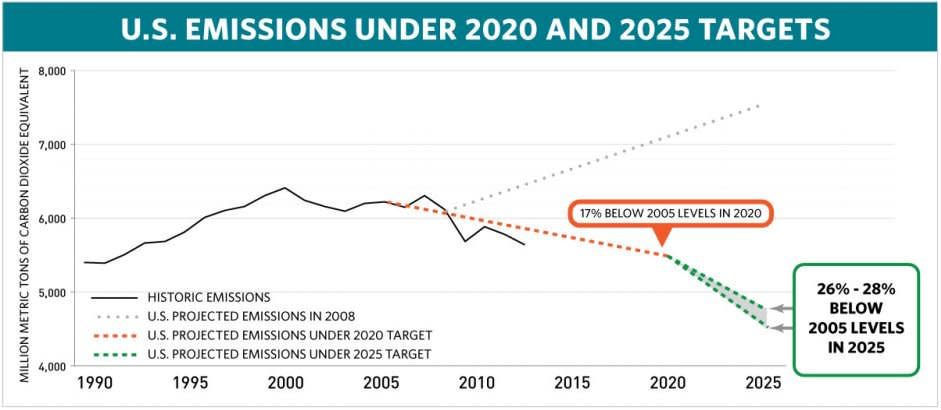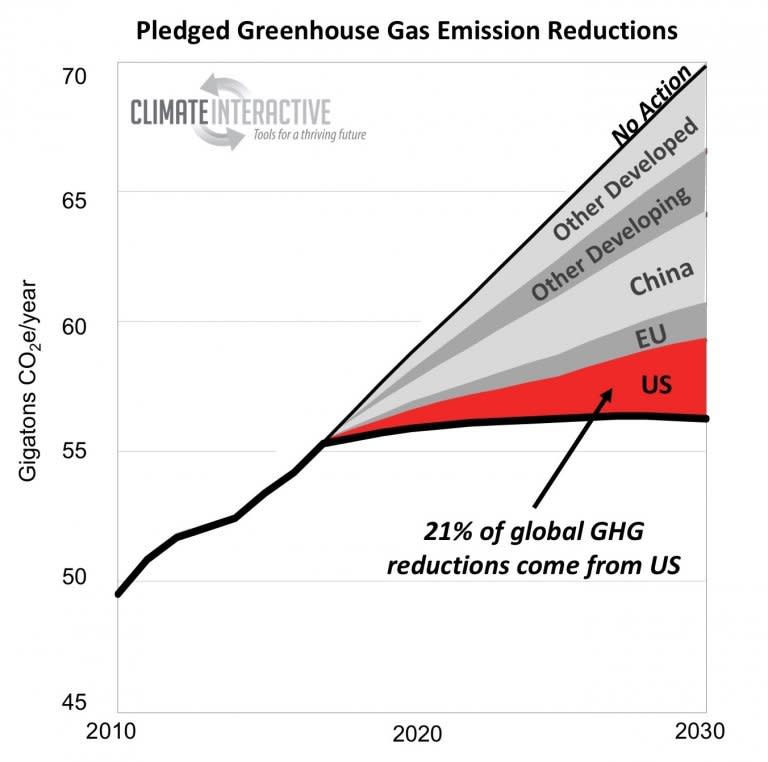Here’s what will happen to the environment if Trump pulls the US out of the Paris Agreement

Sean Gallup/Getty Images
President Trump is expected to announce his decision to pull the US out of the Paris climate agreement this afternoon.
If the US withdraws from the accord, the consequences for the environment will be serious — but the additional carbon dioxide (CO2) and global temperature rise that we should expect depends on what other countries decide to do as a result of the US decision.
As the researchers at Climate Interactive have broken down in a detailed analysis, whatever the US does "matters a great deal," since through 2030, the US part of the agreement is responsible for more than a fifth (21%) of all emissions avoided.
If the US abandons the agreement, Climate Interactive calculates that by 2025, the country would emit 6.7 gigatons of CO2 per year instead of the 5.3 gigatons of CO2 per year that would be emitted following current commitments, raising global emissions by 3%, with even bigger consequences by 2030 (Climate Interactive calculated 2025-2030 commitments based on the Marrakesh climate talks).
If other countries were to stick to the pact, that decision could be expected to warm the world an additional .3 degrees Celsius by 2100. But if the US decision puts other aspects of the Paris Agreement in doubt, the consequences are more complicated.
What the US committed to
When the US signed onto the Paris Agreement in December of 2015, the country set a goal to reduce greenhouse gas emissions by 26% to 28% by 2025, as my colleague Rebecca Harrington has explained.

UNFCCC
There are reasons for ambitious goals — the US is the biggest polluter in history, "responsible for almost a third of the excess carbon dioxide that is heating the planet," according to the New York Times. These days, China emits more CO2 overall than the US, though US citizens still are responsible for more than twice as much CO2 per capita — the most of anyone in the world.
The Paris Agreement is a commitment to try to keep global temperature from rising more than 2 degrees Celsius above pre-industrial levels — something climate experts say is necessary to avoid devastating and irreversible consequences, including rising sea levels, searing heat waves, and more.

Climate Interactive
As the Climate Interactive analysis shows, the pledges countries (the US included) made because of the Paris Agreement alone are extremely unlikely to achieve this goal. The agreement includes plans for countries to revisit their emissions goals periodically. If all countries reached "peak emissions" by 2030 and then cut them at a rate of 5% per year in developed countries and 3.5% per year in developing countries, Climate Interactive estimates that the 2 degree goal could be met.
Consequences of a US departure
But if the US pulls out, the calculus changes.
As of right now, it looks like a number of other countries are on track for hitting the goals they set as a result of the Paris Agreement. China and European allies have committed to sticking with the pact.
However, part of the agreement also included the US and other countries helping fund efforts to reduce emissions in developing countries. Obama pledged $3 billion to a fund dedicated to this purpose, but only $1 billion has been transferred so far. Trump has said he wants to drop those commitments. Countries including India (the third-biggest emitter), China, Brazil, and South Africa have issued a statement urging developed countries to honor their financial pledges in order to reduce emissions.
If a US departure and financial pullback affects the commitments of other countries, here's what Climate Interactive calculates will happen to the environment:
If the US pulls out and reverts to an emissions-as-usual strategy but other countries maintain their current pledges, Climate Interactive calculates that by 2025, the US would emit 6.7 gigatons of CO2 instead of the 5.3 gigatons of CO2 that would be emitted if the US follows its commitments. They calculate this would lead to a temperature 3.6 degrees C above pre-industrial averages by 2100 (uncertainty range 2.1 to 4.7 degrees C).
If Paris pledges are followed by the world but not improved on, Climate Interactive calculates that by 2100, the world will be 3.3 degrees C warmer than in pre-industrial times (uncertainty range 1.9-4.4 degrees C).
If the world were to drop the Paris agreement altogether and follow current trends, Climate Interactive calculates the world would be 4.2 degrees C warmer by 2100 (uncertainty range 2.5 to 5.5 degrees C).
To keep temperatures from rising 2 degrees C by 2100, countries need to reach peak emissions by 2030 and then steadily cut emissions from there, investing in clean energy alternatives to fossil fuels.
Even if Trump decides to pull the US out of the agreement, there are other factors that could change the calculus. State and local decisions, market trends away from fossil fuels, private efforts, and future political administrations may all attempt to achieve the original US pledge, especially if the rest of the world remains committed.
Trump's announcement on his decision to hold to the agreement or leave it is expected at 3:00 pm on June 1.
NOW WATCH: HBO just released a new 'Game of Thrones' trailer — the dragons are back
See Also:

 Yahoo News
Yahoo News 

